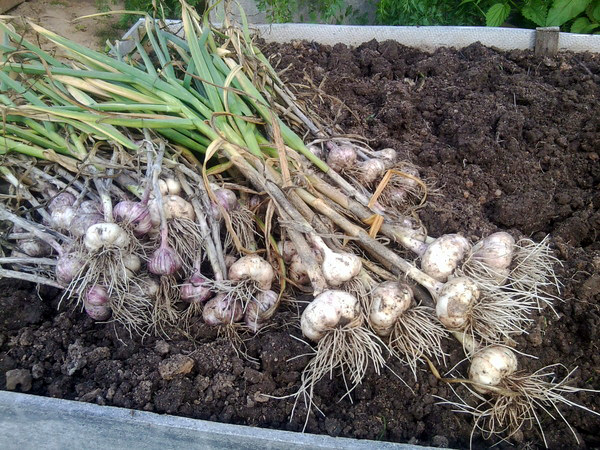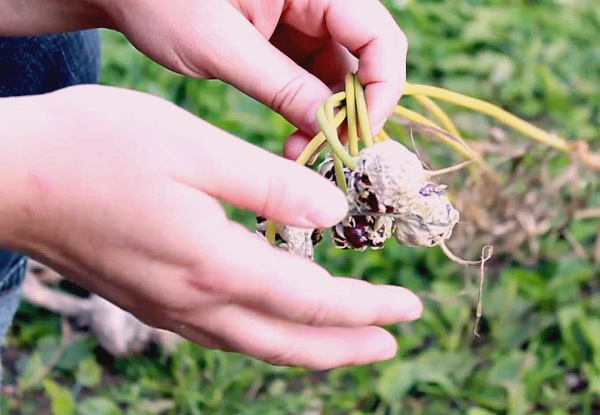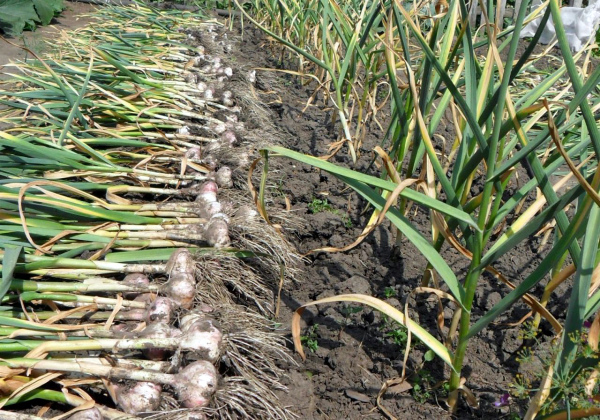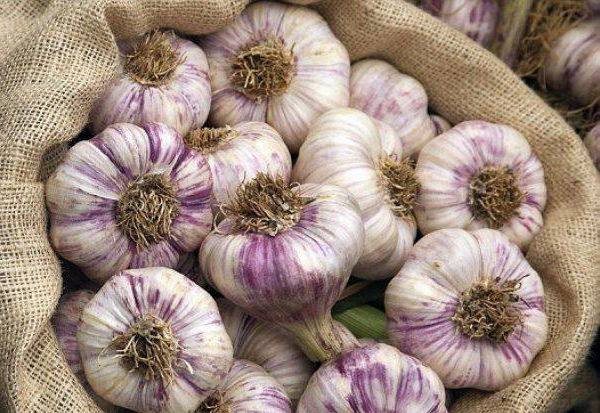We remove garlic in the Moscow region: how and when?
Content
Terms of harvesting garlic
Harvesting time depends on factors such as planting method, climate and weather conditions. Of course, the period from the beginning of the growing season to the full ripening of the bulbs is approximately the same, however, it must be borne in mind that spring comes earlier in the southern regions, and there the garlic ripens faster than in the northern regions.
To a large extent, weather conditions affect the harvest. In moderately rainy summers, garlic bulbs accumulate the maximum amount of nutrients by mid or late July. But if the weather was damp all the time, the garlic should be dug out 1-2 weeks earlier and dried at home. For example, the summer of 2021 turned out to be quite changeable, so it is difficult to say exactly when it is better to dig up garlic. In this case, the condition of the bulbs will be the determining criterion.
The determining factor in harvesting is the way the crop is planted.
There are two types of garlic:
- winter or winter - it is planted in the soil in the fall, and dug up next spring, it is distinguished by large bulbs, erect stems and high yields;
- spring (summer) - planted in spring, and dug it out in the summer of the same year, it is not as large as winter, but can be stored for a long time.
Since these species differ in the growing season of different lengths, they have to harvest at different times.
Winter garlic
In temperate climates, winter garlic begins to ripen by mid-July, and it is traditionally dug up in the last week of the same month - one week is given to the bulbs for ripening. However, in central Russia, as well as in the Moscow region, the harvest period may drag on for another week, since the summer weather in 2021 was not very stable.
Spring garlic
Spring garlic is dug up a little later: in late August - early September. Ideally, it should be harvested about two weeks after the winter crop, but even here it all depends on the climate and weather conditions. In northern climates, harvesting of bulbs can take until the end of September. In the middle lane, harvesting is usually carried out at the end of August. But since there were frequent cold snaps and rains in the summer of 2021, it is possible that the harvest will last until September 10, 2021.
Ripening signs
Experienced gardeners determine the maturity of winter garlic by its appearance. Yellowed lower leaves are the main sign of bulbs ripening.
By the leaves, one can judge about maturity only towards the end of July, since at other times this sign may indicate a lack of moisture in the soil or some kind of disease.
Therefore, there is a more accurate way to determine the degree of maturity of the bulbs. From mid-June, arrows begin to appear in winter garlic. As a rule, they are broken out as they grow, so that the plant can direct all its forces to the formation of heads. But if you leave a few pieces, then it will be possible to navigate by them regarding the ripening time.When the arrows straighten, harden a little, and the seed pod at the end of the arrow cracks and exposes the seeds, this is a sign that it is time to dig up the bulbs.
Spring garlic does not release arrows, and the degree of ripening is determined in another way. Drying and lodging of leaves is the first sign of maturity of spring varieties. At this time, you can dig one head or simply scoop up the earth and examine the bulb. Maturity will be indicated by the following signs:
- the dense head is covered with scales in at least three layers;
- the scales themselves are dense and very strong;
- the teeth are easily separated from each other;
- The thin film on the teeth is easily removable.
For the preservation of the garlic heads, it is very important to timely determine their maturity and dig them out before the time when the scales crack and the teeth are exposed.If it so happened that it was not possible to harvest the crop on time, then such teeth should be recycled as soon as possible, since they are not stored for long. And, of course, it is not recommended to use them as planting material.
Cleaning and storage
You need to harvest garlic in dry, sunny weather, and you should prepare for this process in advance. A month before digging out the heads, it is necessary to stop watering, and in a week you need to shake off the soil around the bulbs a little - this procedure will speed up their ripening.
The digging process itself is as follows:
- first, the bulbs are undermined with a garden pitchfork or a shovel along with the leaves (you cannot pull out and pick out the bulbs, as the teeth will be damaged);
- then the heads, especially the roots, are freed from the ground - this is done by hand, since shaking or knocking the earth against a shovel leads to damage to the teeth and their premature decay;
- the dug out bulbs are laid in rows on the bed for drying for 4-6 days, depending on the air temperature.
Dry leaves and arrows, if any, are not removed immediately, but only when the bulbs are completely dry - this will help the garlic heads to ripen more quickly and improve their quality.
As for the ripening of the bulbs in the garden, there are two opposite opinions. Some gardeners believe that drying the crop right on the bed increases the resistance of the heads to diseases, rotting, and also accelerates ripening. Others, on the contrary, are of the opinion that the crop should be removed from the garden immediately and dried under a canopy. There are several reasons for this. First, at high temperatures, the teeth can get sunburn. And secondly, it may suddenly rain, which is not uncommon for the summer of 2021, and then it will take a long time to dry the heads.
In a dry, well-ventilated room, the crop is dried for 10-14 days. After this time, the heads can be prepared for long-term storage. First you need to cut the roots, and then sort the large and small bulbs. This procedure is quite important, since large heads are stored longer and better - they are left to winter, and small ones can be immediately processed or used for food in the first place.
There are several ways to store garlic:
- weaving of braids (bundles) - for this simple procedure, the stems from the heads are not cut off, but woven into dried reeds, or another material suitable for this;
- cardboard boxes, boxes - for storage in such containers, the stems are cut off to 5-10 cm, and the heads themselves are stacked in a layer of no more than 15 cm, while it is advisable to transfer the layers with parchment;
- wicker baskets are the most successful method, as they provide good ventilation.
- The storage period of winter varieties is not as long as that of spring varieties, so it is better to store them in the cold at a temperature of 3-4 ° C (in a refrigerator or cellar). Summer varieties can be stored at 15–20 ° C until the next harvest. For them, the main thing is that the room is dry.Closer to spring, the garlic heads should be periodically inspected, since it is very important not to miss the moment when the teeth begin to sprout - such heads should be stored separately.
If arrows were left on the bed to determine the ripeness of winter varieties, then they should not be thrown away - this is a very high-quality seed.
The seed pods should be laid out on paper and wait until they dry and begin to crumble. Then you should collect the seeds in a tissue bag and save until the next planting - these small bulbs germinate better than ordinary teeth taken from the head.
Video "Garlic grown in the Moscow region"
In this video you will find out when garlic is harvested in the Moscow region, and what kind of harvest you can get.






